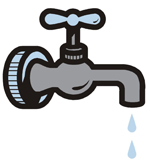| February 25, 2016
|
In This Issue |
|
CWWA News
|
|
|
Federal Initiatives
|
|
|
Provincial News
|
|
|
Research News
|
|
|
CWWA Member Profiles
|
|
|
Upcoming Events
|
|
|
Snippings and Clippings
|
|
After years of what seemed like crying in the wilderness, the stars seem to be aligning for critical infrastructure renewal in our water/wastewater/stormwater industry. The Liberal Party certainly caught my ear during the election when they committed to reinvestment in infrastructure, even if it meant running a deficit of $10 billion. Then they won that election with the public’s support and recommitted to that promise. This week (Feb 22nd), they again confirmed that they are still solid on this commitment to investing in infrastructure to improve our economy – even if runs a deficit of $18 billion. This is very inspiring and a clear signal for all of us to get our projects not just shovel-ready, but as Infrastructure Minister Sohi demands, we need to show that our projects are "shovel-worthy".
|
CWWA is happy to announce the 2015-16 Utility Excellence Awards. These Awards highlight the remarkable work our members are accomplishing in their communities. Water and wastewater utilities perform a vital service, protecting both human health and the environment, and these Awards offer peer recognition of these efforts.
|
The Window on Ottawa is CWWA’s core event featuring presentations from federal departments and national organizations on new initiatives and regulatory developments on a national level. This is your chance to hear what’s coming down the pipe from the federal government.
|
CWWA’s first National Water and Wastewater Conference was a huge success. It truly was a wonderful three days of information sharing, networking and socializing. Our technical program was top notch, and our social activities were fun, and offered some amazing networking opportunities.
Today, nations face an uncertain and complex security landscape in which threats impact/target the physical, social, economic and cyber domains. Threats to national security, such as that against critical infrastructures not only stem from man-made acts but also from natural hazards. The Canada/US Blackout (2003), Hurricane Katrina (2005), Fukushima (2011) and Hurricane Sandy (2012) are examples highlighting the vulnerability of critical infrastructures to natural hazards and the crippling effect they have on the social and economic well-being of a community and a nation.
|
Environment Canada is proposing to collect more contextual information on releases to water by adding the reporting of "non-detect" and concentration values to the National Pollutant Release Inventory (NPRI) for the 2016 reporting year.
|
Environment and Climate Change Canada posted online January 4, 2016, Guide for Reporting to the National Pollutant Release Inventory (NPRI), 2014 and 2015. The NPRI reporting requirements for the 2014 and 2015 reporting years were provided in the Notice with respect to substances in the National Pollutant Release Inventory for 2014 and 2015 published in Canada GazettePart 1 July 12, 2014 edition.
|
The Canadian Council of Ministers of the Environment (CCME) posted a notice of the draft scientific criteria document for Canadian Water Quality Guidelines for the Protection of Aquatic Life– Zinc.
|
The end of the 90-day transition period for the full implementation of the Human Pathogen and Toxins Act (HPTA) and Human Pathogens and Toxins Regulations (HPTR), is February 29th, 2016, and we at the Centre for Biosecurity remain focused on assisting institutions and organizations with a smooth and successful implementation of the pathogen control framework.
|
Last month the BC government posted online, Prepared and Resilient – A discussion paper on the legislative framework for emergency management in British Columbia. The paper is designed to support stakeholder consultations concerning emergency management legislation in BC, and in particular the future of the province’s Emergency Program Act.
|
Last month, Manitoba released its new Drought Management Strategy - one of the commitments in the Surface Water Management Strategy and Manitoba’s Climate Change and Green Economy Action Plan. The strategy provides greater coordination and enhancement of resiliency measures and actions that can be taken by the many communities and stakeholders that are affected by and have expertise in drought
|
Not-for-profit organizations, First Nations and Métis communities, municipalities, schools, colleges, universities, and conservation authorities can get government grants for local projects in their watersheds.
|
Water Canada UBC researchers have developed a tool that is designed to help small to medium-sized cities and towns address the challenges posed by aging drinking water infrastructure in Canada. The tool, developed by Solomon Tesfamariam and Rehan Sadiq, both civil engineering professors at the University of British Columbia’s Okanagan campus, helps municipal water system operators and managers better understand the state of their infrastructure.
|
Lystek International Inc. is an organic materials recovery firm that is helping reduce waste, costs, odors and greenhouse gas emissions through its innovative approach to biosolids and organics management. The multi-use Lystek system can be leveraged to optimize digesters and biological nutrient removal systems while also contributing to landfill diversion and agricultural sustainability. This is achieved by transforming non-hazardous, organic materials into nutrient-rich, federally-registered fertilizers and other, multi-purpose products.
|
New Tecumseth is a town in Simcoe County, in south-central Ontario, Canada. While it is not officially a part of the Greater Toronto Area, it is counted, in terms of the census, as being a part of the Toronto Census Metropolitan Area
|
View a calendar of water events in Canada and internationally.
|
Water Canada News outlets have recently picked up on the water crisis in Flint, Michigan. However, residents in Flint have been living without a safe and reliable water supply for almost two years. Here is what we know so far.
|
Water Online The Obama administration is pointing to a new goal for U.S. water conservation. "We have potential to... reduce water usage by 33 percent. This would bring us closer in line with other industrialized nations, and could reduce the nation’s total CO2 emissions by about 1.5 percent annually," the White House said in a recent announcement.
|
Water Online Avoiding pump failure is a top equipment goal for water utilities because even minor pump problems can create big messes. But experts see hope for improvement in pump management by means of data analytics.
|
OCWA Loss of nitrification, poor floc formation and freezing are just a few of the challenges that wastewater treatment plants face during the cold winter months. "Experience, preparation and careful record keeping are critical factors to ensure consistent compliance with discharge standards and avoiding unplanned outages," says Jim Nardi, OCWA Wastewater Systems Manager - South Peel Facilities.
|
TPOMAG My older brother brings an insulated jug of water along when we go fishing. On it he has written "BWIFI" in bold black marker. It stands for: Bottled Water Is For Idiots. What has this to do with the water situation in Flint, Michigan? Actually, something pretty important. One thing that’s happening around the country since the Flint disaster is that people are asking questions about the tap water quality in their own communities.
|
Water Online Researchers say algae found in freshwater lakes and reservoirs may be linked to illnesses including Alzheimer’s Disease and Motor Neurone Disease (MND). They published their findings last month in the scholarly journal Proceedings of the Royal Society B.
|
CBC News It may not be the most alluring name for a weekend event, but organizers are hoping for a big turnout at this weekend's "Sewer Stroll" around Sydney Harbour. Otherwise billed as the "Harbour Hop," it's a chance for birdwatchers to catch a glimpse of some of the many birds that flock to Cape Breton during the winter.
|
Vice.com It may have taken five years, but Canada may finally be getting some green artillery that won't poison people. In the process, military scientists have found a more effective and cheaper type of ammunition that could reduce the environmental impact of war across the board.
|
The Globe and Mail The Liberal government needs to boost spending on water infrastructure and assessment of groundwater resources to ensure the health of the Great Lakes, as they face threats from climate change and unsustainable use, the International Joint Commission urged.
|
Global News A wastewater treatment process developed by a fledgling Canadian business made history near the South Pole last month, and the original idea for it has its roots in a northeast Edmonton garage.
|
Water Canada The Federation of Canadian Municipalities (FCM) released its 2016 Federal Budget submission this week, proposing solutions and a strong partnership with the federal government to solve national challenges. The budget submission lays out a plan for investments in public transit, affordable housing, and climate change mitigation and adaptation. The submission highlights the importance of prioritizing upgrades to local wastewater treatment facilities deemed high risk and requiring action by 2020 under new federal regulations, and expanding upon the Green Infrastructure Fund.
|
|
| |
|






















